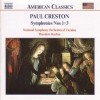传记
Paul Creston (born Giuseppe Guttoveggio; October 10, 1906 – August 24, 1985) was an Italian American composer of classical music.
Born in New York City to Sicilian immigrants, Creston was self‐taught as a composer. He was an honorary member of Phi Mu Alpha Sinfonia music fraternity, initiated into the national honorary Alpha Alpha chapter. His work tends to be fairly conservative in style, with a strong rhythmic element. His pieces include six symphonies, a number of concertos, including two for violin,[1] one for marimba and orchestra[2] (premiered by Ruth Stuber), one for one piano, one for two pianos, one for accordion and one for alto saxophone (the latter dedicated to Cecil Leeson),[3] a fantasia for trombone and orchestra (composed for and premiered by Robert Marsteller), and a Rapsodie again for alto saxophone - written for Jean-Marie Londeix. He also wrote a suite (1935) and a sonata (op. 19, 1939) for alto saxophone and piano (both dedicated to Cecil Leeson),[3][4] as well as a suite for organ, Op. 70.[5] Several of his works were inspired by the poetry of Walt Whitman. He died in Poway, California, a suburb of San Diego.
Creston was one of the most performed American composers of the 1940s and 50s. Several of his works have become staples of the wind band repertoire. Zanoni, Prelude and Dance and the Celebration Overture have been and still are on several state lists for contests across the USA.
Creston was also a notable teacher, with the composers Irwin Swack, John Corigliano, Elliott Schwartz, Frank Felice, and Charles Roland Berry, accordionist/composer William Schimmel and the jazz musicians Rusty Dedrick and Charlie Queener among his pupils. See: List of music students by teacher: A to C#Paul Creston. He wrote the theoretical books Principles of Rhythm (1964) and Rational Metric Notation (1979).







